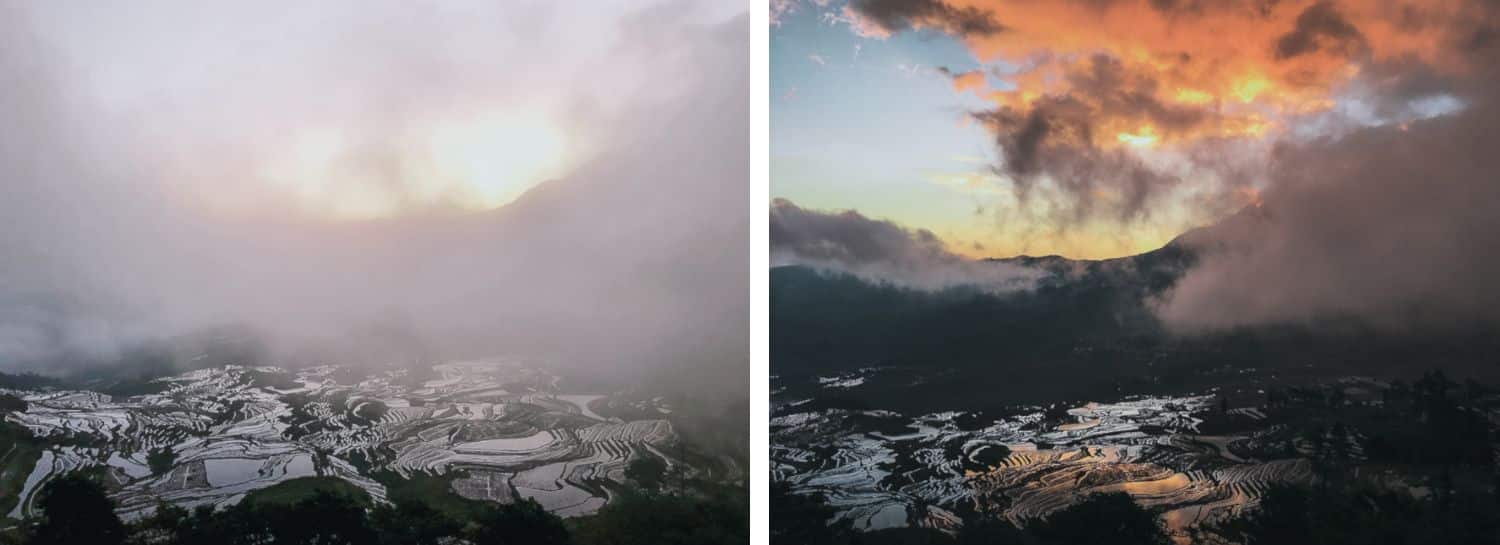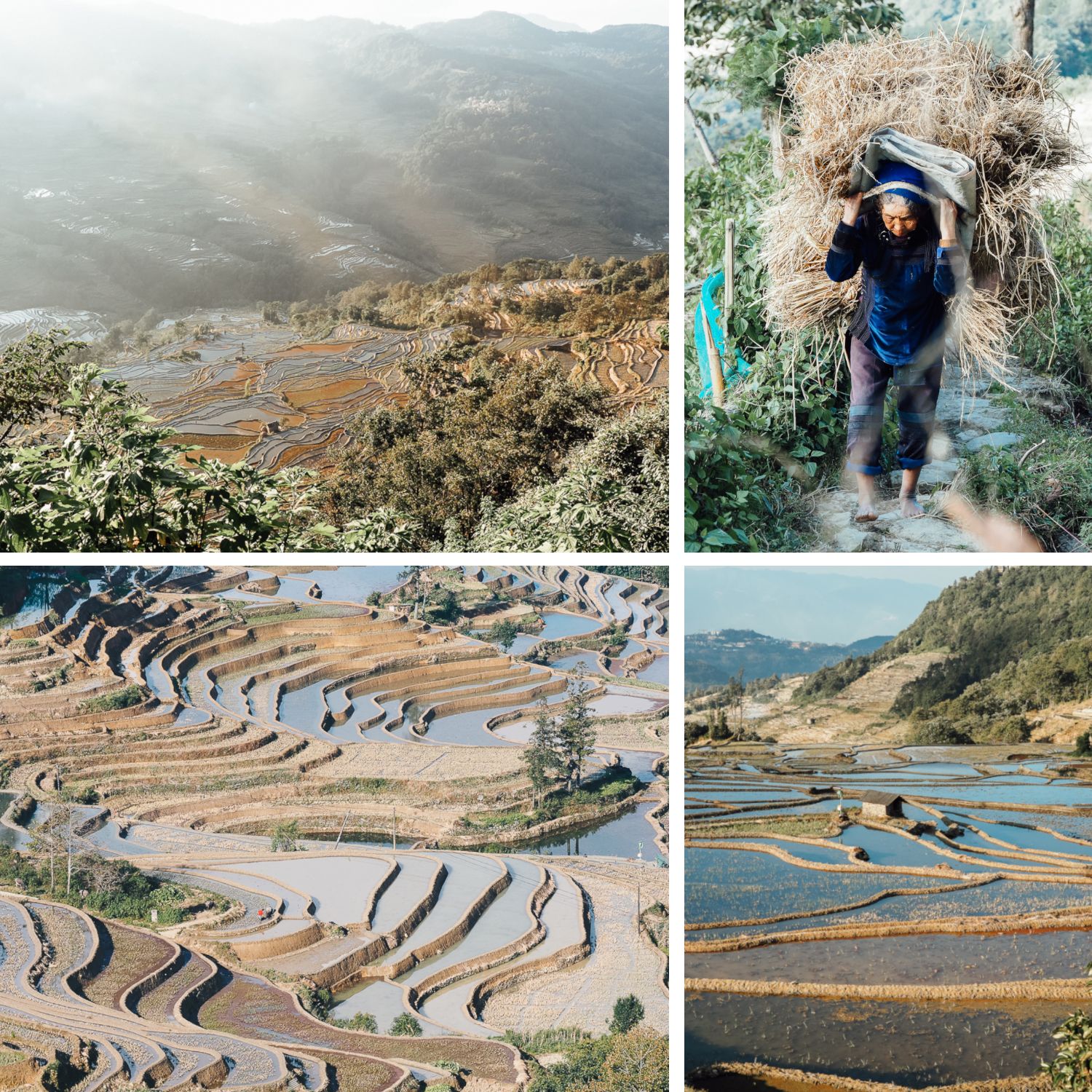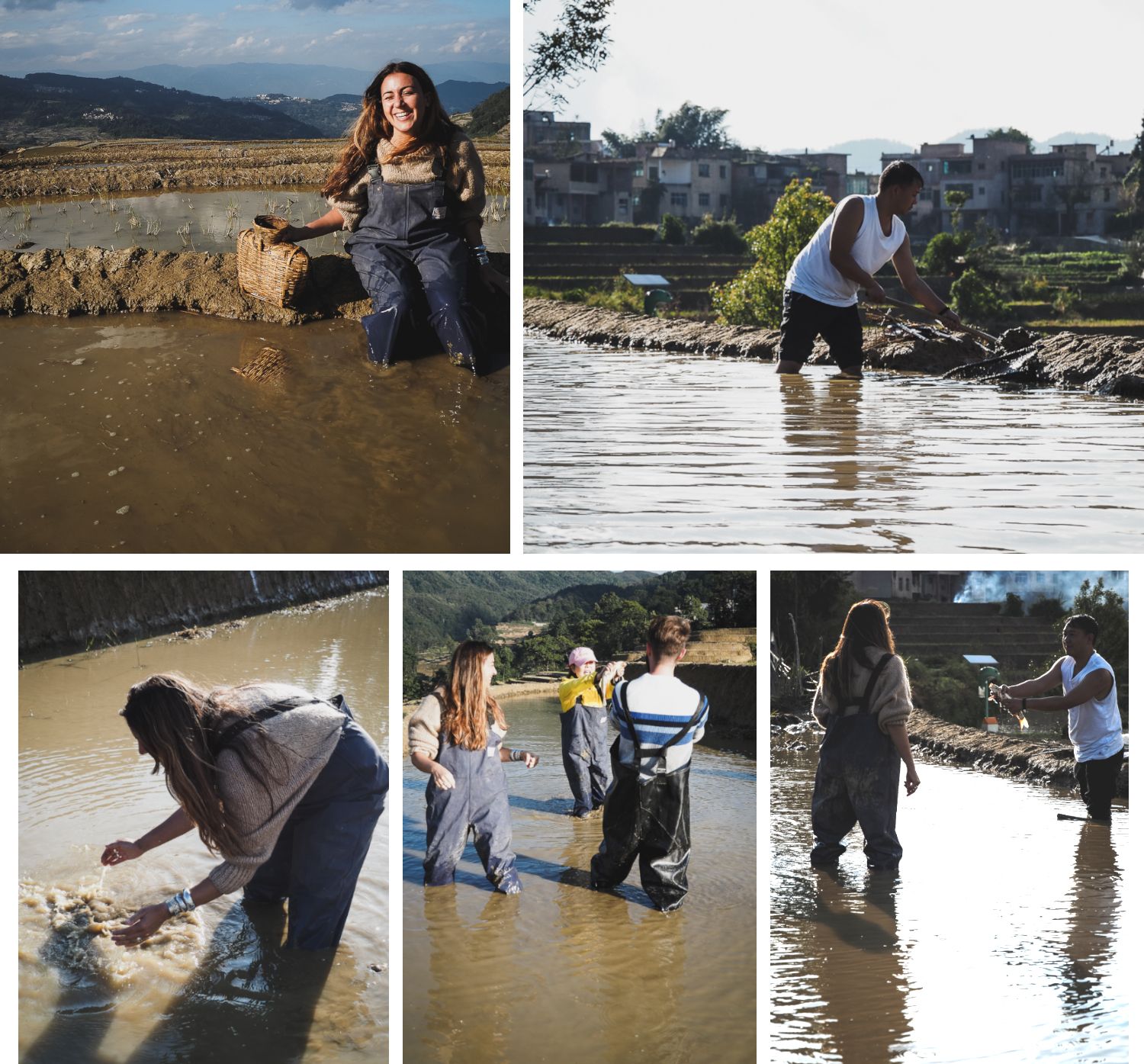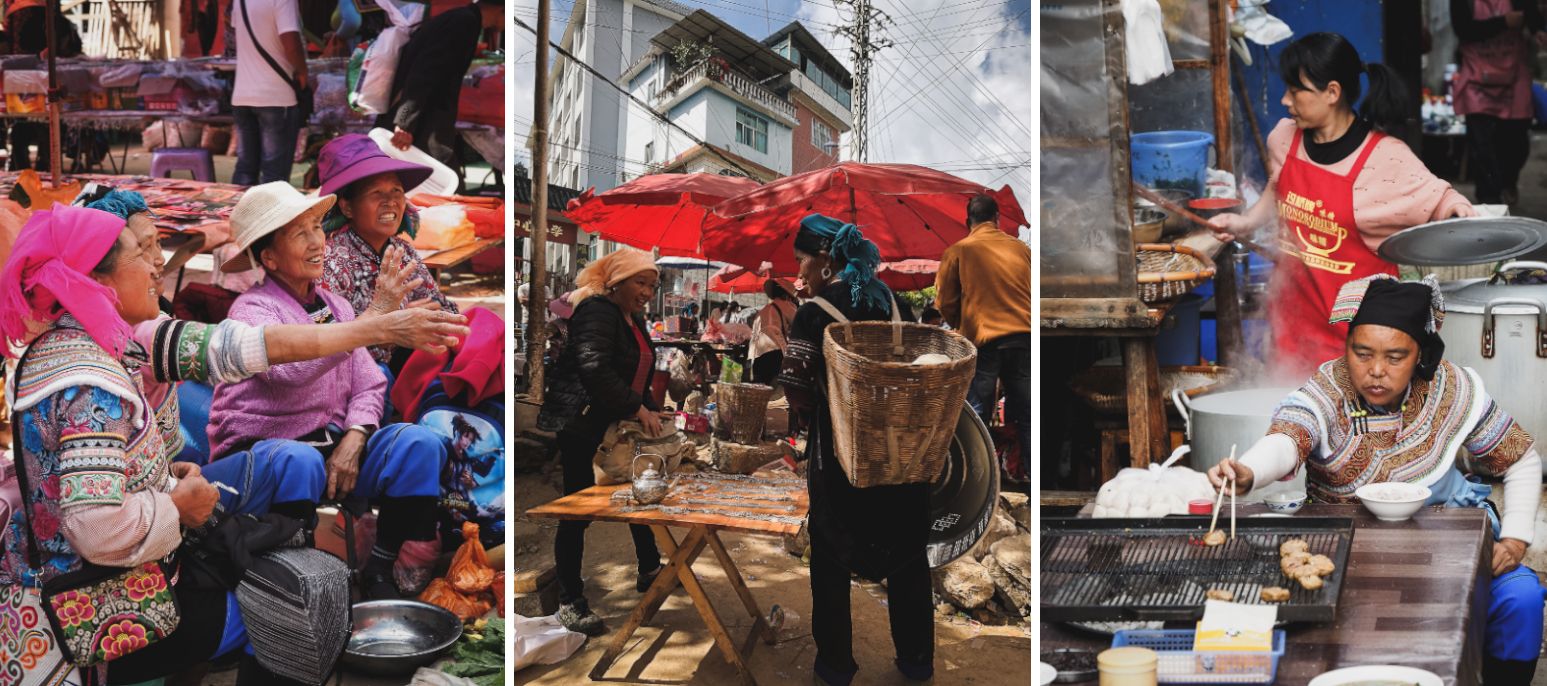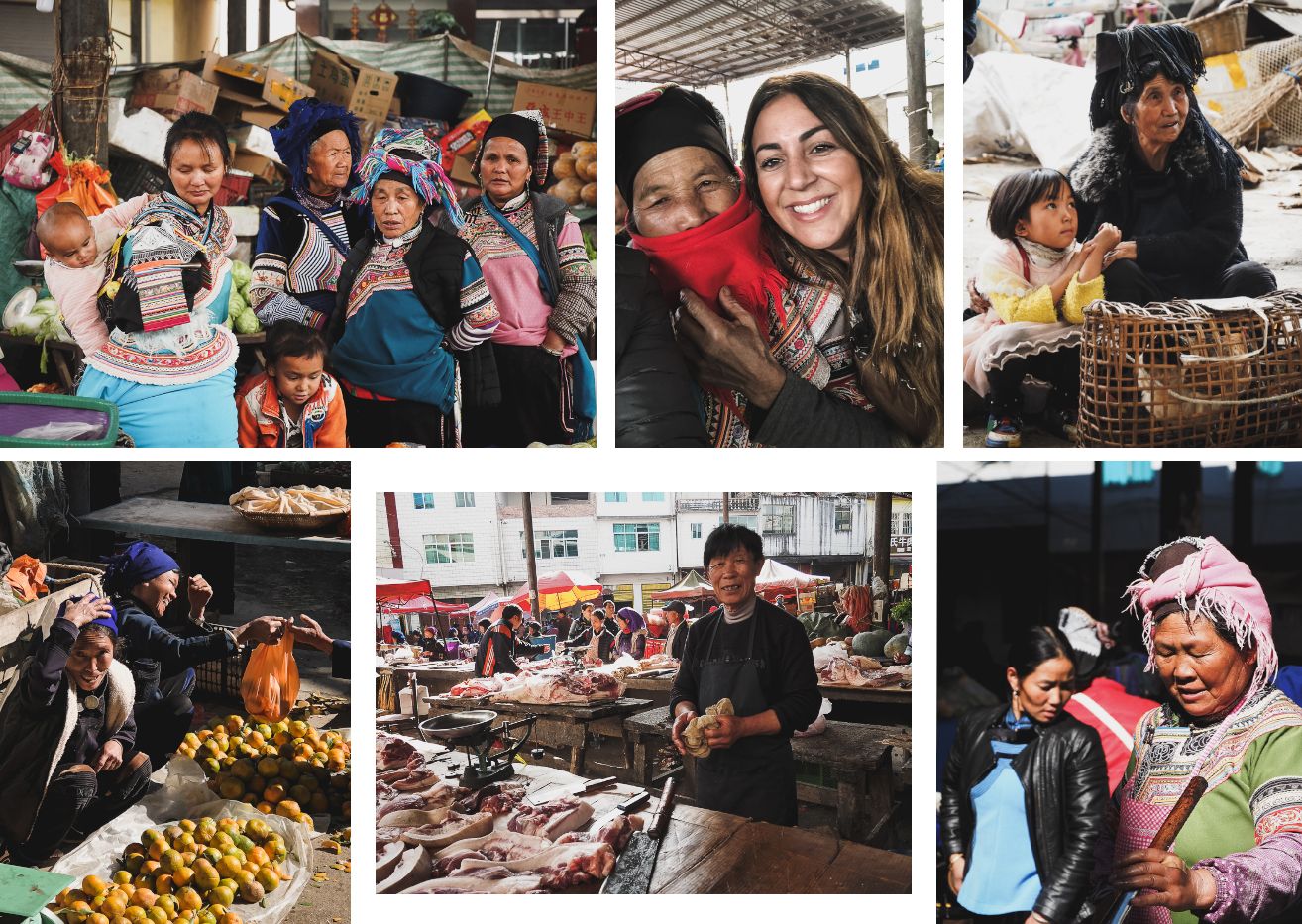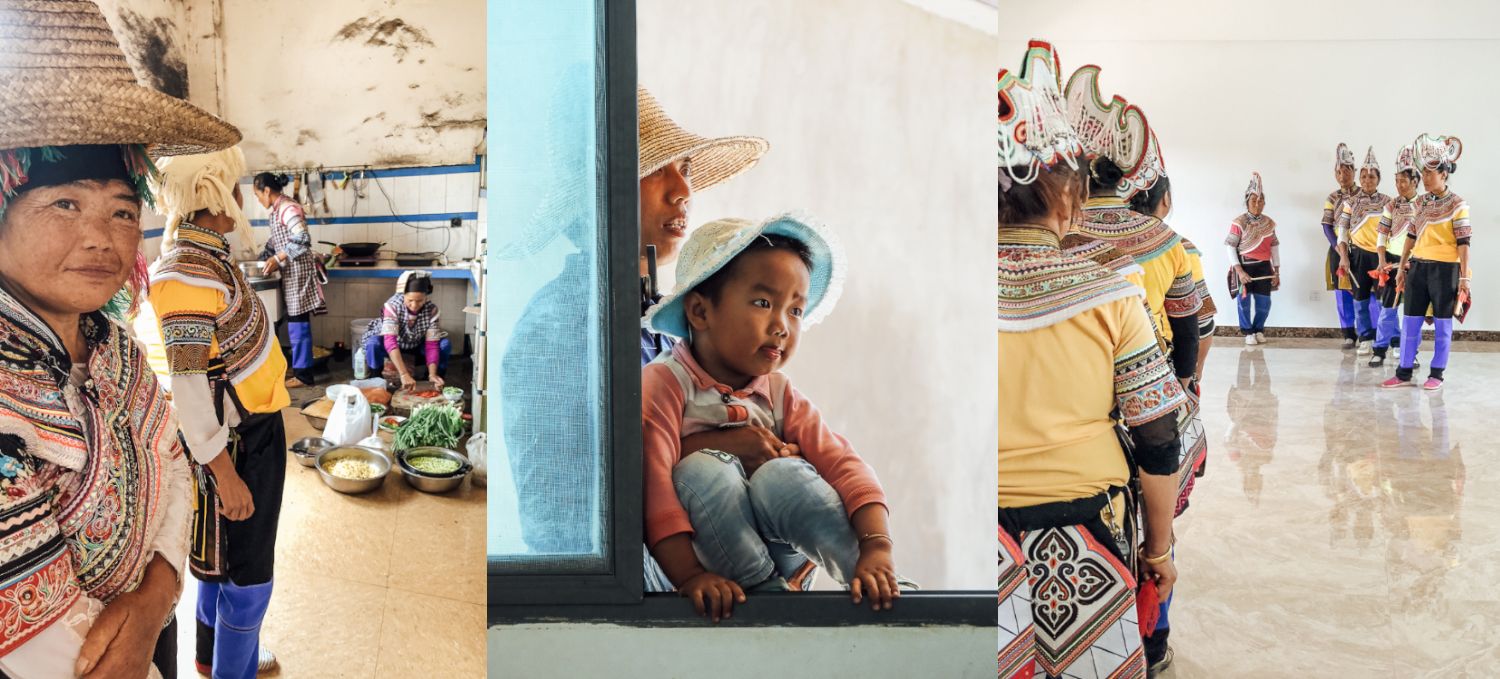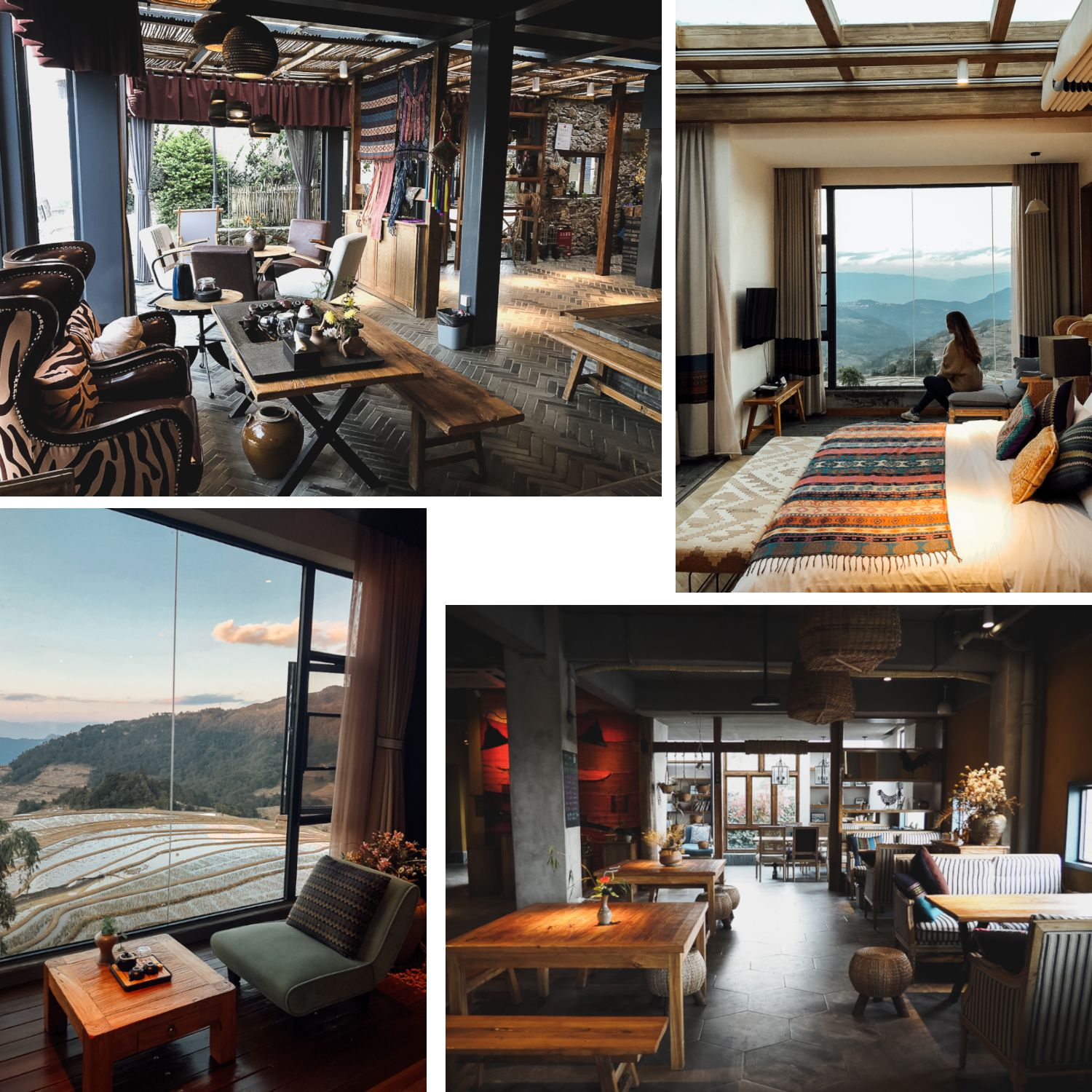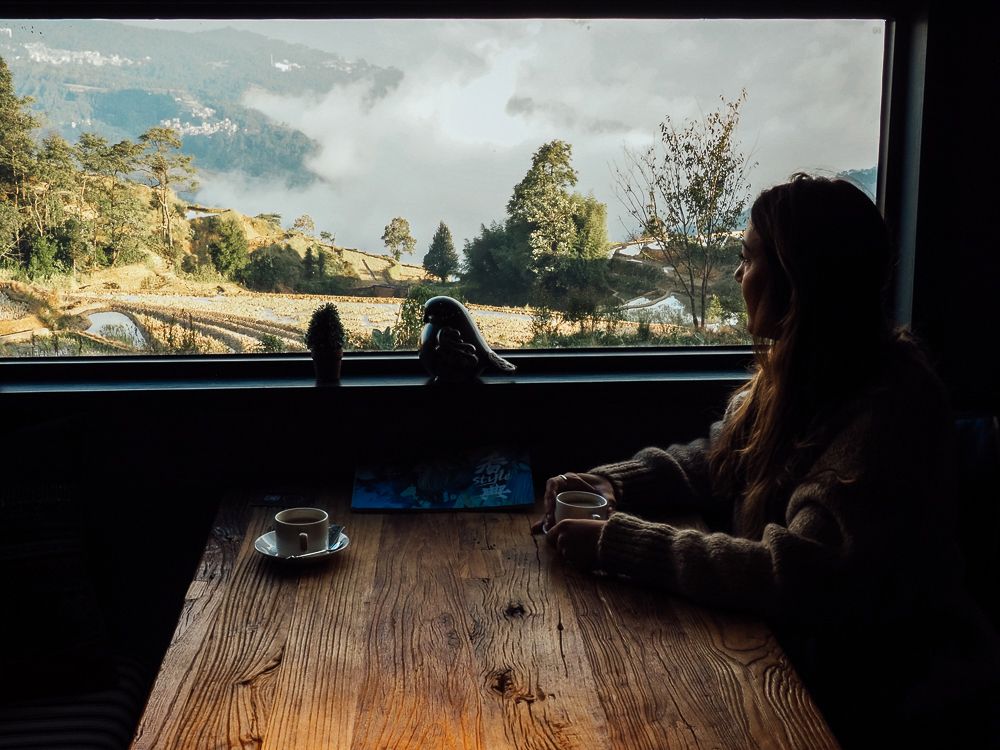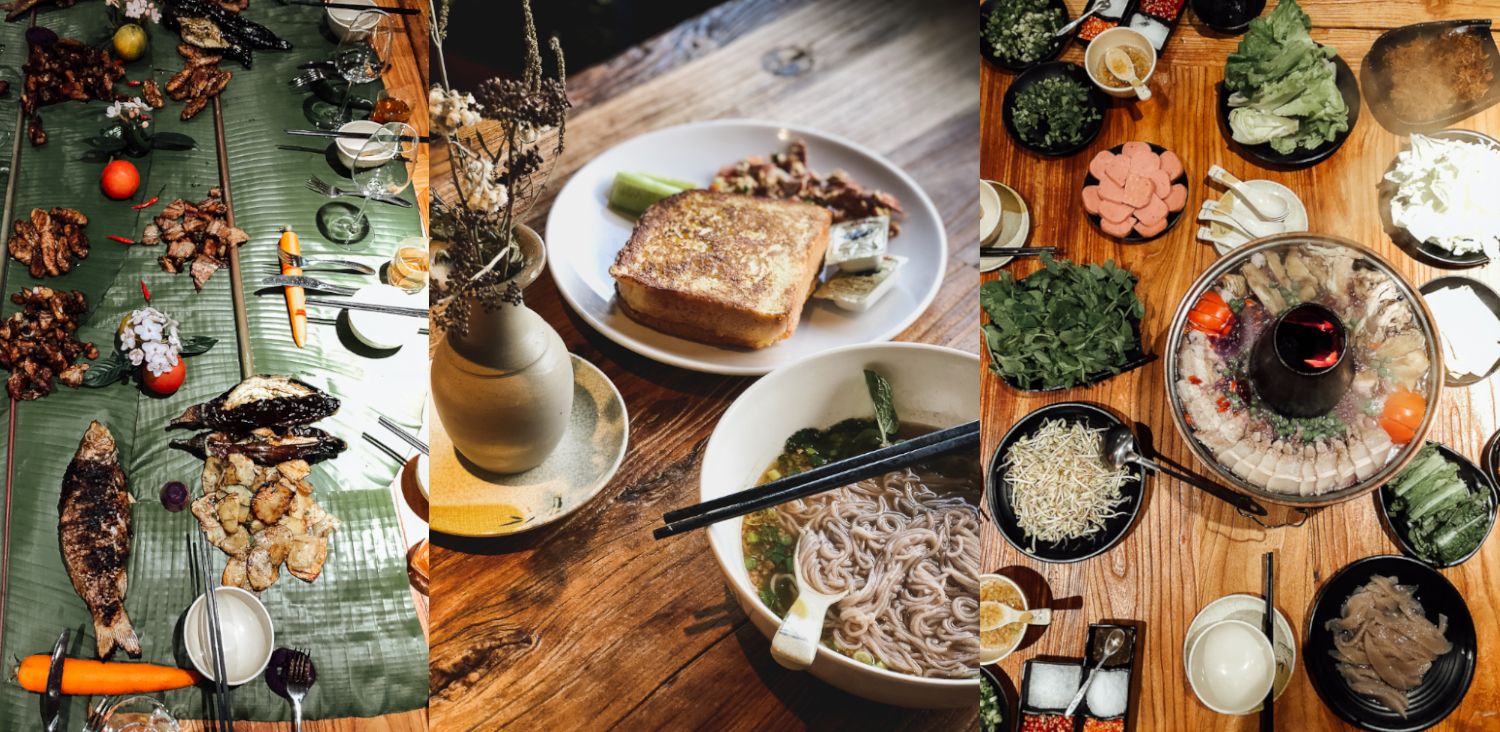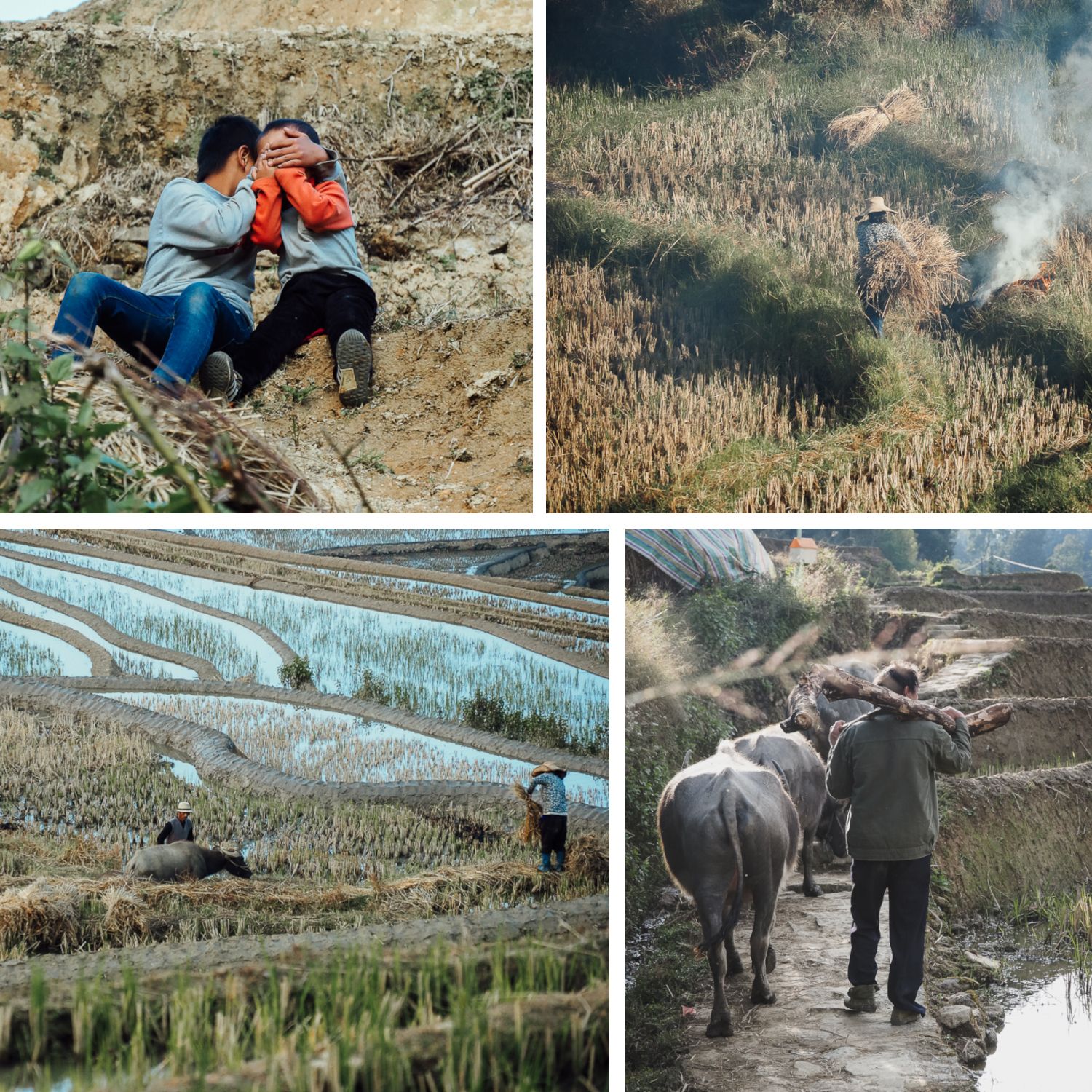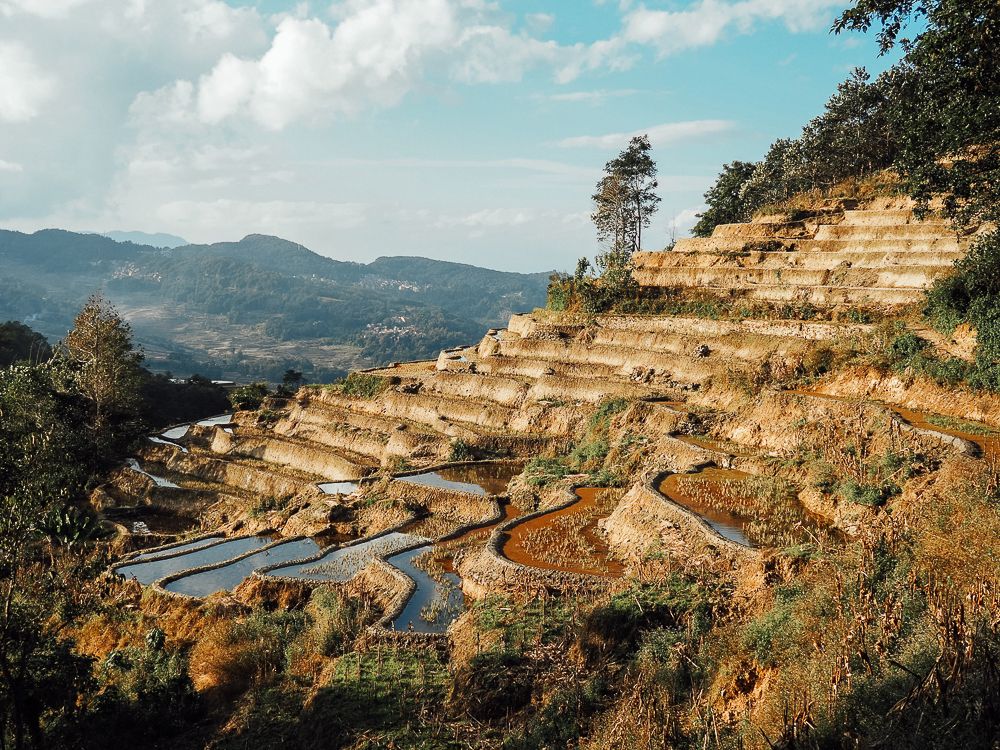
Yunnan was a real “coup de coeur”! That’s why I wanted to share with you these few days spent in the rice terraces of Yuanyang and our encounters with the ethnic minorities of the neighboring villages.
TABLE OF CONTENTS :
THE RICE
From Kunming, it’s a 7-hour drive to a beautiful Unesco World Heritage site, the famous Yuanyang terraced rice fields. As it’s a big day’s drive from Kunming, we recommend cutting it short with a visit to the Shilin.
The rice fields are incredibly beautiful, scrupulously sculpted on different levels in the mountains by the Hani minority who have inhabited the region for centuries. I wondered how man had managed to create all this! I recommend admiring the rice paddies at sunrise at point of view of Duoyishu. It was a magical moment and a real motivation to get up early… very early! Once you’ve paid the entrance fee, you’ll come to a wooden walkway built high up for a 180°C view. There were a few tourists already set up with their cameras and drones, but it wasn’t difficult to squeeze in and find a seat. The terrace is quite large and offers a number of different angles, including a sunken one that brings you a little closer to the panorama. The first glimmers are dark at first, giving the landscape a mystical atmosphere with black and gray colors as if it had been drawn with charcoal! When the sun’s first rays break through the clouds and splash into the water, the light changes to orange. Be patient, the weather can be foggy, so you’ll have to wait patiently for it to clear! Mother Nature has put on a wonderful show for us!
At the end of the day, head to the rice fields to watch the sunset. From our hotel, just take the hiking trail on the right and follow the signs. It takes about 2 hours to reach the Ba Da’s point of view. It’s a very pleasant hike, skirting waterfalls and rice paddies, which this time are a lovely shade of orange and gold. The landscapes are lush and green, and you’re sure to see some beautiful rural scenes: buffaloes and peasants in the fields, village minorities tending the rice, children playing with skipping ropes – it’s pure joy for photos and emotions. I have incredible memories of it! The panorama is less impressive than Duoyishu’s, but the colors are really very beautiful and warmer. Other hikes around the hotel allow you to observe the rice paddies from different angles; ask the hotel for details.
If you still have some time left in the rice fields, I suggest you try an activity offered by the hotel: fishing in the rice fields! Dressed in overalls and fisherman’s boots, head out to one of these ponds to fish in the traditional way. It’s worth noting that the rice paddies don’t yield rice from November to March, so the Chinese found a way to exploit the rice fields. They raise fish, which means they don’t have to buy them at the market, and they make ends meet. What’s really impressive is walking on the little mud paths that lead from one pool to the next. You need to have a good sense of balance, as these paths are fine, uneven, hard and soft all at once! I wasn’t too sure about diving into one of these pools, as I didn’t know how deep we’d be going below the surface. But I wanted to take up the challenge and the sensations are there: it’s not easy to move around in the water and fish at the same time. To make it easier, lower the water level to make the fish appear. You then have to catch them with your bare hands by pressing them to the bottom of the water or to the sides of the pool before slipping them into a very pretty wicker basket! Believe me, it’s not easy at all, they don’t give in easily and are quite cunning (and I must admit I was a bit disgusted to feel their cold, thick skin). We still managed (well, I didn’t) to catch 3 that ended up on our plates that very evening!
WHEN TO SEE THE YUANYANG RICE FIELDS?
The best time to visit is from November to April. The rice fields around Yuanyang are filled with water every year from December to February. Rice starts growing in May. From June onwards, the rice paddies change color and turn green. From July to September, they begin to yellow. The rice harvest lasts throughout October, then the fields are cleaned and re-watered between November and December. Be aware that the rhythms are always a little different from one rice field to another, from one farmer and one village to another, which means that in some months of the year, you may see rice fields overflowing with water and others that have not yet been harvested.
YUNNAN MARKETS
Yuanyang, this is the minority region Dai, Yi and Hani but also scenes of life, colorful markets and this is without a doubt for me my big favorite of Yunnan. We took the opportunity to discover the secluded Niujiaozhai also known as village Corne de boeuf a 40-minute drive from our hotel. The road to get there from Yuanyang is superb, lined with pretty rice fields. It’s a great opportunity to stroll through the market and admire the superb traditional costumes worn by the women, as well as to sink beneath the huge hall where the locals cook and have lunch. The locals are very friendly and welcoming, and don’t hesitate to invite you to join them for lunch! I found myself sitting on a mini stool enjoying grilled tofu in the company of a curious and touching family. We also stopped for lunch at a small local village bouiboui where smoked meat was being prepared. At first glance, the place didn’t look appealing, but as usual, we ate very well!
Then on to the village of Niuxin. We went there on the day of their annual party. There were fifty families from the Dai gathered under a huge courtyard, ready to sing and dance! Imagine our faces and theirs when they saw 10 European tourists arrive! It was a mixture of excitement, euphoria and discovery, as we were the only Westerners there to admire the festivities. A superb moment rich in encounters and discoveries.
After an evening at the hotel, washed down with rice alcohol and a good night’s sleep, it’s time for day two and the discovery of the Shengcun. This market is still different from the first, but it’s still a delight to stroll through the stalls of fruit, vegetables and meats. At lunchtime, a home-cooked lunch was planned in the house of the village chief of the Yi. The setting was pretty and in its natural state, but I only regret not having been able to chat more with the women who welcomed us. Then it was time for the local song and dance show, but it didn’t leave me with any exciting memories. Even though they invited us to dance, I found it a bit overrated! What I remember most are the encounters with the young children and their beautiful smiles!
On the whole, these markets fascinate me because they give you a glimpse of the real China. The women are still dressed in colorful traditional outfits, different according to their allegiance: they carry huge open wicker baskets on their backs, where fruit and vegetables are thrown. It’s a lively show, a feast for the eyes and for conversation, and an event not to be missed if you come to Yunnan.
WHERE TO SLEEP AND EAT IN THE RICE FIELDS OF YUANYANG?
In terms of location and value for money, I’d definitely recommend dining at the boutique hotel. the Twelve Manor. It’s a rather upscale address, but so unique! It even contrasts with the tiny village and surrounding dwellings. Ideally located for exploring the rice paddies, the hotel is tastefully decorated in a very natural, cocooning spirit with warm tones. You’ll find wood, beautiful crockery, quality rattan furniture, but the must-see rooms with their huge picture windows overlooking the rice paddies! Special mention for the suite with its glass roof! This hotel is just perfect and the staff are very helpful and lovely!
Visit us at Twelve manor and try out our themed dinners. We were able to taste a succulent Chinese fondue for 88 RMB/p, but also at a barbecue of meat and fish, all beautifully decorated and arranged on huge palm leaves. A treat for only 90 RMB / person. Chinese fondue is quite widespread in China, and remains very convivial whether you’re vegetarian or not. It consists of a charcoal-heated broth, placed in the center of the table, in which you cook all the foods shown in front of you (meat, vegetables, tofu, mushrooms, lotus, potatoes…). Breakfasts are copious, varied and delicious, with a choice of continental or local. Don’t hesitate to try the small boui boui and markets during the day, which serve delicious, tasty food. The food is really good and cheap! (10 to 20 RMB). Time to chat with the locals! Be careful, it can be a bit spicy!
It all depends on the season in November, but expect to pay around 750 RMB per night (about €100).
This article is our experience. This trip was made possible thanks to a collaboration with China Roads whom we thank for their invitation and this discovery.
